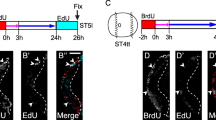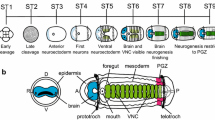Abstract
Large gaps of knowledge exist regarding postembryonic brain morphogenesis of the zebrafish Danio rerio (Cyprinidae, Teleostei). The zebrafish represents – together with the frog (Xenopus), chick and mouse – one of four major models for the genetic study of early brain development. Here, we used normal silver-stained Bodian material and immunohistochemical material stained with a monoclonal antibody against the proliferating cell nuclear antigen (PCNA, cyclin) to study the morphogenetic appearance and location of proliferation zones of the zebrafish brain between day 1 and day 10, focussing on the forebrain at day 5 postfertilization. Our results directly demonstrate that the dorsal telencephalic proliferation zone (i.e. the pallium) extends – consistent with the process of eversion – some distance laterally on top of the telencephalon. The subpallial telencephalic proliferation consists of dorsal and ventral zones. The preoptic region also includes dorsal and ventral proliferation zones. In the diencephalon proper, separate proliferation zones are present in the habenula, and in the periventricular cell masses of the dorsal thalamus, the ventral thalamus, and the pretectum. More ventrocaudally, the latter three massive proliferation zones appear to be replaced each by thinner, but distinct proliferation zones. Two of them represent ventrocaudal continuations of the dorsal and ventral thalamus and lie in the region referred to as the posterior tubercular area in adult teleostean neuroanatomy. The third lies in the region of the nucleus of the medial longitudinal fascicle. In addition, several hypothalamic proliferation zones are present. The data for the diencephalon are largely in agreement with the neuromeric model of brain organization of Puelles and Rubenstein (1993), which is mostly based on amniote data. Generally, the understanding of the prosomeric origin of teleostean prosencephalic cell masses may be regarded as pivotal for their comparative interpretation.
Similar content being viewed by others
Author information
Authors and Affiliations
Additional information
Accepted: 14 September 1998
Rights and permissions
About this article
Cite this article
Wullimann, M., Puelles, L. Postembryonic neural proliferation in the zebrafish forebrain and its relationship to prosomeric domains. Anat Embryol 199, 329–348 (1999). https://doi.org/10.1007/s004290050232
Issue Date:
DOI: https://doi.org/10.1007/s004290050232




